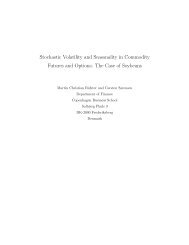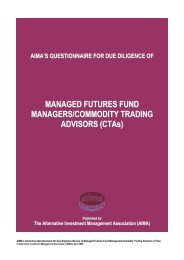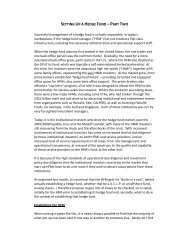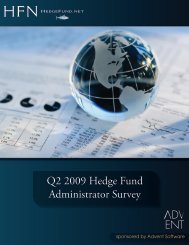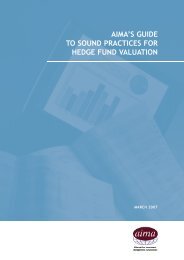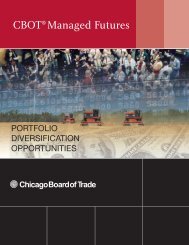Lintner Revisited: A Quantitative Analysis of Managed ... - CME Group
Lintner Revisited: A Quantitative Analysis of Managed ... - CME Group
Lintner Revisited: A Quantitative Analysis of Managed ... - CME Group
You also want an ePaper? Increase the reach of your titles
YUMPU automatically turns print PDFs into web optimized ePapers that Google loves.
cmegroup.com<br />
MANAGED FUTURES AND PERFORMANCE DURING<br />
FINANCIAL MARKET DISLOCATIONS<br />
The volatility and market dislocation that accompanied the<br />
subprime mortgage crisis, credit crunch, and explosion and collapse<br />
<strong>of</strong> commodities prices during the second half <strong>of</strong> 2007 and 2008,<br />
was briefly alluded to earlier in this paper. The diversified mix <strong>of</strong><br />
investments many institutional investors had relied upon failed to<br />
generate returns. The major U.S. and Global equities market indices,<br />
the S&P 500 and MSCI World, performed dismally, returning -37.94<br />
percent and -39.90 percent, respectively, from August 2007 when<br />
the credit crisis began, through December 2008.<br />
Most alternative investments, which had promised absolute returns,<br />
disappointed investors as well. The HFRI Fund Weighted Composite<br />
Index, an equally weighted index designed to represent the returns <strong>of</strong><br />
hedge funds across all strategies, returned -17.21 percent from August<br />
2007 through December 2008. The HFRI Equity Hedge (Total)<br />
Index, which includes hedge funds whose core holdings consist <strong>of</strong><br />
equities and therefore does not benefit as much from diversification<br />
as the HFRI Fund Weighted Composite Index, returned -25.06<br />
percent. Private Equity and Real Estate Investment Trusts,<br />
represented by the LPX Buyout Index and the S&P/Citigroup World<br />
REIT Index, returned an atrocious -71.91 percent and -47.40 percent,<br />
respectively, from August 2007 through December 2008. CTAs,<br />
however, capitalized on the market dislocations <strong>of</strong> 2007 and 2008,<br />
providing managed futures investors with returns <strong>of</strong> 17.57 percent<br />
over the same period, as measured by the BTOP 50 index.<br />
Ramsey and Kins posit that “though not a hedge, CTAs <strong>of</strong>ten<br />
perform very well when markets are under extreme stress, and<br />
have a high probability <strong>of</strong> adding value to an existing portfolio<br />
during difficult market conditions” (Ramsey and Kins 2004,<br />
134). This is because managed futures tend to capture massive<br />
flows <strong>of</strong> capital as markets reestablish equilibrium in the wake <strong>of</strong><br />
new information or in the transition from one economic cycle to<br />
another. It cannot be emphasized enough that managed futures<br />
are not and should not be treated as a portfolio hedge, but rather<br />
as an additional source <strong>of</strong> non-correlated returns, as this paper has<br />
demonstrated.<br />
Although managed futures returns tend to be uncorrelated to other<br />
investments over the long run, correlations are non-stationary over<br />
shorter time horizons and may temporarily converge during crisis<br />
conditions. Ramsey and Kins point to “the case <strong>of</strong> exogenous events<br />
like the failed Russian coup in the 1990s or September 11, 2001”<br />
as examples where managed futures would not have been effective<br />
as a portfolio hedge and would have experienced losses alongside<br />
other investments and actively managed strategies (Ramsey and<br />
Kins 2004, 130). Not all market dislocations are the same, making<br />
CTAs vulnerable to rapid reversals or the sudden onset <strong>of</strong> volatility.<br />
The reaction <strong>of</strong> managed futures strategies to price action is path<br />
dependent, and the response <strong>of</strong> the program to prevailing price<br />
action during a crisis determines performance, at least in the shortterm.<br />
Certain generalizations about CTA returns and the market<br />
conditions that generate them do tend to result in bouts <strong>of</strong> strong,<br />
positive performance during certain kinds <strong>of</strong> market dislocations.<br />
The majority <strong>of</strong> CTAs trade “long volatility” strategies, which tend<br />
to produce a positively skewed distribution <strong>of</strong> monthly returns. The<br />
long option/positive gamma returns pr<strong>of</strong>ile originates from the tight<br />
control <strong>of</strong> downside risk relative to less frequent outsized returns,<br />
suggesting that these managers generate the majority <strong>of</strong> their<br />
returns during lower frequency, high impact events. In contrast,<br />
most hedge fund strategies have fat left tails in their distributions <strong>of</strong><br />
returns since they perform well under normal conditions but suffer<br />
infrequent, large losses under highly volatile conditions and should<br />
therefore be considered short volatility strategies (Ramsey and Kins<br />
2004, 130). These “tail events” for CTAs and hedge funds tend to<br />
coincide with massive shifts <strong>of</strong> capital which create trends in global<br />
equity, interest rate, and commodities markets stemming from a<br />
flight to or from quality. Any dislocations which catalyze trends <strong>of</strong><br />
this sort can and <strong>of</strong>ten do result in strong performance for managed<br />
futures.<br />
22<br />
Past performance is not necessarily indicative <strong>of</strong> future results.


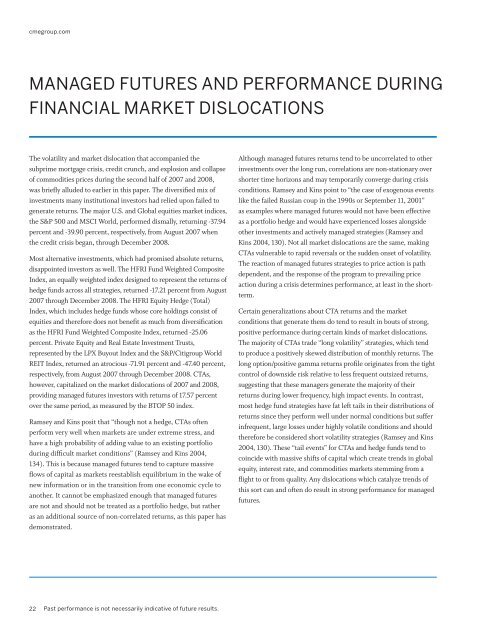

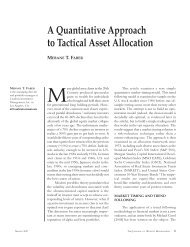

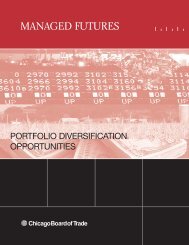
![Definitions & Concepts... [PDF] - Cycles Research Institute](https://img.yumpu.com/26387731/1/190x245/definitions-concepts-pdf-cycles-research-institute.jpg?quality=85)
